The green anaconda (Eunectes murinus) is a species of constrictor snake of the Boidae family.
It is considered the largest of all snakes of this family living in the Amazon basin, and even in the entire American continent, and the longest snake in the world. It is also on the list of the largest snakes on the planet, competing with the Asian python reticulata, famous for its weight (up to 250 kg) and its length (up to 8 m).
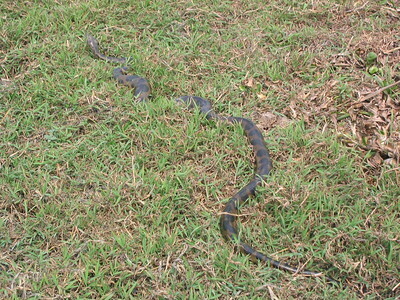
But the green anaconda is longer, as the female can reach a total length of 10 m, although it is less bulky than the python reticulata, generally weighing between 35 and 85 kg, although specimens weighing 97 kg have been reported.

The green anaconda is the largest among other species of the genus Eunectes: E. beniensis, E.deschauenseei, E. notoeus (Milord 2012).
These large snakes, the green anaconda and several species of python (the python reticulata and the silk python), are generally hunted because of the fear they instill, often exaggerated, which has caused their conservation to reach the level of endangered species in some regions.
However, these large snakes are not venomous; they kill by suffocating their prey. And they only attack humans in self-defense, when provoked.
Where does the anaconda live? (habitat)
The green anaconda is aquatic or semi-aquatic, diurnal or nocturnal, and can live both in water and in trees.
It can be completely submerged for 10 minutes, and then bring its nostrils to the surface.
For hunting, it prefers lentic water bodies, from sea level to 1,000 m above sea level.
It dives into the water, keeping its nostrils out, on the lookout for a thirsty animal approaching to drink.

Source: Gossipguy[CC BY-SA 4.0].
The anaconda is a species endemic to the Amazon basin, and is widely distributed in the Amazonian regions of Colombia, Venezuela, Bolivia, Ecuador, Peru, Brazil, Guyana, French Guiana, Suriname. It is also found in some Caribbean islands.
What does the green anaconda eat? (food)
It is, together with the Orinoco crocodile(Crocodylus intermedius), a major predator of some of the animals of the bush, such as the capybara, chiguiro or capybara(Hydrochoerus hydrochaeris). Specialists point out that the green anaconda rarely lives more than ten years.
Sexual Disformity
The green anaconda is a notable case of sexual dimorphism, since the female specimen is much larger and heavier than the male, which reaches a length of 4 to 5 m, and a weight that hardly exceeds 35 kg.
Description of the species
The skin of the green anaconda is dark green, dotted with black and ochre patterns or spots on the sides or flanks. The color becomes lighter in the belly area.
The terminal part of the tail has yellow and black patterns, which generally differ from one specimen to another.
The large snout is covered by six thick scales, three on each side, which characterizes the genus Eunectes and differentiates them from snakes of the genus boa.
The entire body is covered with scales, except for the caudal part, near the cloacal area. There appear a sort of spurs, or remains of their lost locomotive extremities.
The tail has a particular design pattern, which is an exclusive drawing for each specimen, as if it were a human fingerprint.

On the other hand, the anaconda’s head is triangular, large but narrow.
The eyes appear at the top of the head, as well as the nostrils. This circumstance favors breathing and its perception capacity.
A skilled hunter
For hunting, it uses the olfactory receptors on its large, black, forked tongue. It has loreal pits and dilatable pupils, making it easy to locate prey in the dark.
The anaconda, despite its length and weight, moves with great agility. However, its movements are relatively slow, and it moves at a maximum speed of 11.3 km/hour.
To hunt, it moves its tongue, which is its olfactory organ, connected to Jacobsos’ organ, located in the upper part of the mouth to perceive odoriferous particles, detect sounds, as well as the movement of prey by means of vibrations in the substrate (Place and Abramson 2006).
Thermal vision
In addition, they can detect the presence of nearby animals only by the heat they radiate, distinguishing the distance and size of the possible prey.
Before combat or when hunting prey, it dives into the water and curls its body into a ball, protecting its head, getting ready to attack. It then excretes a substance with an unpleasant odor.

Its large build, size and weight give it a powerful strength and resistance that allows it to squeeze its prey until it suffocates it, no matter how big it is. This is how it proceeds with capybaras, deer, tapirs, monkeys, etc. It does so in a few seconds.
When on land, it climbs trees to hunt its prey. He coils her up with his body, carries her into the water and suffocates her, preventing her from breathing. It opens its mouth, unhinging its jaws, and swallows the prey whole, helping itself with its four rows of teeth, starting at the head to avoid getting stuck.
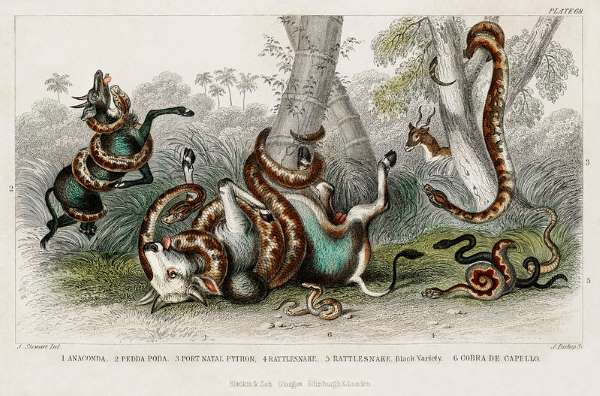
To swallow their prey and digest it, their esophagus and stomach are very thin, but flexible and resistant to withstand the action of gastric juices that break down the bones of their victims.
The digestion of a large prey can last several weeks, remaining inactive in the soil, or resting in the water. It has a slow digestion, and does not need to eat daily. It can even last without eating for up to 8 months.

Anaconda devours a capybara or chigüire(Hydrochoerus hydrochaeris). Exhibited at the Senckenberg Museum in Frankfurt-sur-le-Main. Source: Eva Kröcher(Eva K.) CC-BY-SA 2.5
Perhaps, in the jungle, the jaguar(Phantera onca) is its only predator.
Sometimes she is self-deprecating. It happens when it stops, and it must feed in the middle of its inactivity and the season is dry.
Anaconda reproduction
Female anacondas reach sexual maturity between 3 and 5 years of age.
They attract males by means of an olfactory signal.
Several males come to her call and court her for weeks, competing for the female’s favor.
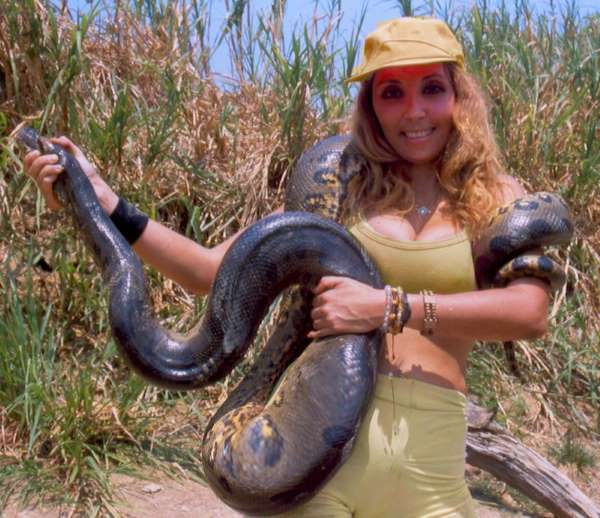
In the last week, as many as thirteen males have been counted, curling in a ball around the female, vying to reach her cloaca.
The female anaconda is polyandrous, that is, a female copulates to reproduce with several males.
Since she is bigger than the male, she submits him, choosing the one she prefers, which is usually the biggest and strongest.
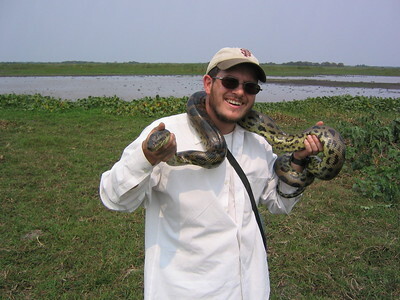
The male moves his tongue and his spurs become erect.
He rubs against it. The male spurs stimulate the caudal region of the female. Copulation is completed when the female raises her cloaca towards the male.
Then, the male embraces her tightly, squeezing her tail and lower body around her. The tails of both curl, and the cloacae come into contact, producing insemination. The gestation period lasts seven months, and they are oviparous.
Uses of anaconda parts
The meat of the anaconda is edible for many indigenous peoples. Its leather is used to make leather goods. Such as wallets, purses, handbags, belts. Its use, however, is greater in traditional folk medicine.
Butter from large snakes, such as anaconda and boa, are used as an effective medicine to reduce inflammations, as pointed out by clinical evidence (Cabrera- Pachacama 2018, Ferreira et al 2014, Alves et al 2013a, Alves et al 2013b ), and as a wound healer (Souza et al 2017, Silva 2008).
For this reason, butter is one of the most sold products in the markets of Amazonian cities (Pinto and Maduro 2002). It is also recommended for rheumatism and asthma (Alves and Rosa 2007).
An endangered species
Its usefulness, especially therapeutic, is a threat to its conservation status, although it has hardly been evaluated.
In several red lists of reptiles, such as that of Ecuador, the anaconda appears as an “endangered species”.
Their situation is aggravated by the fact that they are hunted for their meat and skin, and especially for some of their organs to be used as medicines.
The destruction of their habitat and hunting by ranchers is another contributing factor to their conservation.

They kill her because they see her as a threat to their herds. Thus, ranchers and settlers altered many parts where the anaconda used to live: they dried up the most fragile marshes and morichales, causing the alteration of the ecosystem of the species’ habitat, proceeding in a different way than the Amazonian indigenous people do.
Myths of the anaconda
Ophidians are among the animals that have produced the greatest amazement to mankind throughout history.
Their unusual appearance, their speed, the deadly poison they inoculate, their forked tongue, their way of living in the shadows, hiding under stones or dry leaves, or climbing tree branches, the surprise they cause and the skill with which they act.
December 14, 2019

Amazonian myths and legends about ayahuasca
December 14, 2019
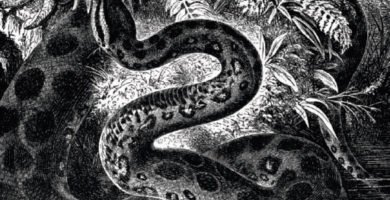
The anaconda in some Amazonian myths and the origin of the Universe
October 5, 2019
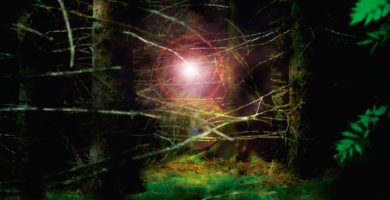
Myths of the Amazon Rainforest
The myth of the man-anaconda
The fascination they produce has turned them into frequent symbols in many indigenous cosmogonies, particularly in the Amazon basin, where they are associated with a supernatural being called “guíos” in some ethnic groups.
Guidance is the transformation of a human into an animal.
Some indigenous legends relate that a man was offended in his dignity by his wife, who had made denigrating comments about him with other women.
To fulfill his revenge, he was transformed into an animal, taking the form of an anaconda that lived in the morichales.
When his wife went to look for the fruits of the moriche or buriti (Mauritia flexuosa), a palm that grows in flood zones, the anaconda man trapped her and penetrated her body repeatedly until she was exhausted, and then took her with him (Parra-Dusán, Amparo Rodríguez 2005: 111).
Influence of anacondas in art
The fear aroused by large ophidians, which remind us of death, has attracted the attention of novelists, storytellers, poets, painters and film directors.
The Uruguayan writer Horacio Quiroga (1878-1937), one of the masters of the Latin American short story, dedicated two of his most famous stories to it: “Anaconda” and “The Return of Anaconda”, in which an anaconda is the protagonist.
Another writer, Mathias Bradley, wrote a novel “The terror of the Amazon Rainforest”, also directly related to a group of anacondas that escape from a research center in the middle of the Amazon rainforest, and become monstrous when they come into contact with a toxic chemical substance.
Another novelist, this time Peruvian, Arturo Hernández, in his novel Sangama, written in 1942, recounts the combat between an anaconda, the Yacumama, and a jaguar, in which the snake wraps the feline’s body and takes it to the water to drown it.
Anaconda: the movie
Modern cinema has made the anaconda an object of horror in several blockbuster films, such as the Anaconda series films of the late 1990s.
Although anacondas and boas have been portrayed with a negative and scary image, specialists in herpetology (the study of reptiles and amphibians) show us shy animals that shy away from humans and only attack them if they feel they are being attacked.
The remote ancestors of anacondas and boas
Snakes are descended from lizards, as they are basically large lizards that have lost their legs.

About 140 million years ago, saurians began to dig the earth. To do so, they had to adapt their bodies: they developed a transparent scale like a fixed eyelid to protect their eyes, and a horny skin in the form of scales, with a hard, rigid and impermeable texture similar to human fingernails.
In that transit they lost their external ear, in a certain way their sense of hearing. They do not have ears or eardrums, but they pick up sounds and vibrations on the ground, thanks to two bones in their skull, the mandible and the columella, which pick up sounds and transmit them to the inner ear.
The scales they developed were very convenient for body protection, but became “uncomfortable” as they grew and had to be changed.
That’s why they do it every so often, and become irritable during the process. Snakes used to resemble lizards: they had four legs and two lungs, and began to differentiate 130 to 140 million years ago.
Primitive and evolved snakes
They formed, then, two groups: primitive snakes and evolved snakes.
The primitive ones were represented by boas, including anacondas, and pythons, which retained their two original lungs and tiny traces of their legs on their skeletons.
The evolved ones have only one lung, and are represented by two types: non-venomous snakes (called “snakes”) and venomous snakes, which are vipers, rattlesnakes and cobras.
“Snake” and “viper” are thus antonymous terms.
Snakes (non-venomous) and vipers (venomous)
Venomous snakes generally have a triangular head, a slit under each eye known as a loreal pit, and their scales are opaque, although they may be colored.
The non-venomous ones, on the other hand, usually have a flattened head, lack a loreal seta and their scales are shiny. As can be seen, anacondas do not comply with these rules.
Titanoboa or Giant Anaconda?
Some specialists name it as titanoboa, specifically Titanoboa cerrejonensis.According to the reconstruction of fossil remains found in a coal mine in Cerrejón, in what is now the department of La Goajira, Colombia, this species may have measured more than 13 meters long and weighed 1,135 kg.
They place it in the Paleocene, in South America, some 60 to 58 million years ago.
Using this fossil, an animated reconstruction was made with metal parts, 14 meters long and weighing 90 kg, which was exhibited at Grand Central Station, New York, in 2012, to promote a TV documentary, “Titanoboa, The Monster Snake”, presented by the Smithsonian Channel on April 1, 2012 (Mead, Bloch and Moreno-Bernal 2013).
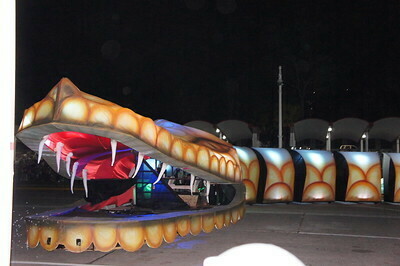
Boas and anacondas
Anacondas and boas belong to the Boidae family. The name boa comes from the Latin term “boa”, which means “ox-killer”.
Many interchangeably call both genera, Eunectes and Constrictor, as if they were one and the same, and use the same terms to designate them. But there are significant differences between the two.
The Boa constrictor constrictor (red-tailed boa) is smaller than Eunectes murinus (green anaconda), both in length and weight. The boa has a labial pouch, while the anaconda has a loreal or thermoreceptor pouch.
Both detect temperature changes in the environment, especially in potential prey, but the loreal seedeater is more complex and complete, detecting changes down to 0.0001 °C, and both visible light (as we do) and infrared radiation.
Both are good swimmers, but the anaconda’s aquatic vocation is greater than that of the boa.
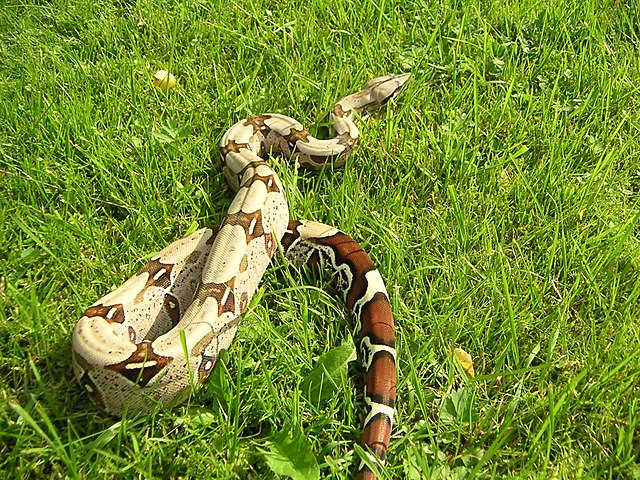
The description of the characteristics of boas is practically similar to those of anacondas: forked tongue, a highly developed sense of smell (using the tongue to smell the air and detect chemical substances), they have a less developed sense of hearing (they lack an external ear and eardrum).
They differ basically in length, weight, body color and tail design patterns, but both share their habitat (one more in the water, the anaconda), their primary centers of origin and even the prey they eat and their predators.
The most representative among other boa constrictors: B. c. amarale, B. c. c. Imperator, B. c. longicauda, B. c. melanogaster, B. c. occidentalis, is the red-tailed boa(Boa constrictor constrictor), distributed from northern Mexico to Argentina. It lives from sea level to 1,000 meters above sea level.
Description of boas.
The B.c. constrictor is the largest of the boas, reaching up to 4 m in length in the wild, well characterized by the bright red color at the end of its tail.
Along the body it has dark spots on a light beige background.
Its belly is cream colored, with black dots.
Its head is wide and, on each side, behind the eyes, it shows a dark stripe. His eyes are round.
It has numerous small teeth.
It has small scales on the top of the head and on the sides of the muzzle.

On the back of the body and on the tail it has black, yellow and red stripes or rings.
It has vestigial organs in the pelvic girdle as nails on each side of the cloaca.
Females are larger than males, and are said to live up to 20 years in the wild and up to 30 years in captivity.
Behavior of boas
The red-tailed boa, or matacaballos (Ecuador), or patacona (Colombia), is a solitary animal with nocturnal habits.
It spends most of its time suspended in the branches of trees or inside a hollow trunk or in an abandoned burrow of large nets.
From there it goes out at night to hunt, compensating for its poor eyesight with the help of its thermosensitive scales, to catch lizards, birds in their nests, opossums, bats, rats and other rodents, squirrels.

It captures the bats, from the trees, in full flight. It kills its prey by constriction until it suffocates them.
It swallows them whole, from the head. It lasts for at least a week, depending on the size of the prey.
It is preyed upon, in turn, by felines and birds of prey. It is threatened by habitat destruction, overhunting (for its skin and medicinal lard) and illegal trade for use as a pet.
For this reason it is also a species bred in captivity. It is not an aggressive animal unless attacked (Pazmiño-Otamendi and Guerra-Correa 2019, Enriquez 1999).
Reproduction
The female attracts males by secreting pheromones. The male passes over the female, pressing her gently, inciting the female to ovulate. The male inserts one of his two hemipenes, or spurs, into the female’s cloaca to deposit his sperm. At four months, after molting, they give birth to 20 to 60 live young, 25 on average, with a length between 30 and 40 cm (Santoyo-Brito 2007).

Dr. Rafael Cartay is a Venezuelan economist, historian, and writer best known for his extensive work in gastronomy, and has received the National Nutrition Award, Gourmand World Cookbook Award, Best Kitchen Dictionary, and The Great Gold Fork. He began his research on the Amazon in 2014 and lived in Iquitos during 2015, where he wrote The Peruvian Amazon Table (2016), the Dictionary of Food and Cuisine of the Amazon Basin (2020), and the online portal delAmazonas.com, of which he is co-founder and main writer. Books by Rafael Cartay can be found on Amazon.com
BIBLIOGRAPHY
- Alves R.R.N. Oliveira T.P.R., Rosa I.L. 2013. Wild Animals used as Food Medicine in Brazil. Evidence-Based Complementary and Alternative Medicine. 2013, 1-12.
- Alves R.R.N., Neira W.L.S., Santana G.G., Vieira K.S., Montenegro N.G.P. 2013. Herpetofauna used in traditional folk medicine: conservative implications. In: Alves R.R.N., Rosa I.L. (Ed.). Animal in Traditional Folk Medicine. Implications for Conservation. Berlin: Springer, 109-133.(PDF)
- Alves R.R.N., Rosa I.L. 2007. Zootherapy goes to town: the use of animal based remedies in urban areas of NE and N. Brazil. Journal of Ethnopharmacology 113 (3), 541-555. (PDF)
- Cabrera-Pachacama E. 2018. Evaluation of the anti-inflammatory effect of Boa constrictor fat , commercialized in the commercial emporium of Gamarra-La Victoria. Lime. Norberto Wiener University. URI: http.// repositorio.wiener.edu.pe /handle/123456789 / 1381. (PDF)
- Carvajal-Campos A. 2017. Eunectes murinus. In: Torres-Carvajal O., Salazar-Valenzuela D. Reptiles of Ecuador . Quito: Museum of Zoology. Pontificia Universidad Católica del Ecuador (PUCE).
- Corporación Autónoma Regional del Valle del Cauca. 2010. Guide to amphibians and reptiles. Conservation area of the Quebrada Pericos micro-watershed. Colombia: Direción Técnica Ambiental. Biodiversity Group.
- Enriquez S. 1999. Amazonian herpetological fauna. Representative species. Quito: Abya-Yala.(PDF)
- Ferreira F.S., Brito S.V., Sales D.L., Henaos I.R.A., Coutinho H.D.M., Souza E.P. 2014. Anti-inflammatory potential of zootherapetics derived from animal used in Brazilian traditional medicine. Pharmaceutical Biology. 52, 1403-1410. (PDF)
- Halliday, T., Adler, K. 2007. The Great Encyclopedia of Amphibians and Reptiles. Madrid.
- Head J.J., Bloch J.I., Moreno-Bernal J. 2013. Cranial Osteology Body Size. Systematics and Ecology of the Giant Paleocene Snake Titanoboa cerrejonensis. Journal of Vertebrate Paleontology, 33 (3), 140-141.
- Jiménez-Amaya R. 2005. Indigenous traditional knowledge, 103-111. In: Parra-Dusán C., Amparo-Rodríguez G. (Eds.). Ethnic communities in Colombia. Culture and Jurisprudence. (Book) Bogotá: Centro Editorial Universidad del Rosario.
- Lillywhite H.B. 2014. How snakes work. Structure, function and behavior of the world’s snakes. Oxford: Oxford University Press.(PDF)
- Lindemann L. 2009. Boa constrictor. In: Animal Diversity Web.
- Martins M, Oliveira M.E., 1998. Natural History of Snakes in Forests of the Manaus Region, Central Amazonas, Brazil. Herpetological Natural History, 6 (2), 78-150.(PDF)
- Mattison C. 1995. The Encyclopedia of snakes. New York: Facts on File.
- Milord L. 2012. “Eunectes murinus” Animal Diversity Web.
- Murphy, J.C., Henderson R.W. 1997. Tales of Giant Snakes: a Historical Nature History of Anaconda and Phythons. Florida: Krieger Company Malabar. (PDF)
- O’Shea M. 2007. Boas and pythons of the world. London, UK: New Holland Publishers.
- O’Shea M. 1994. Eunectes murinus gigas (Nortern green anaconda). Cannibalism. Herpetological Review , 25 (3), 124.
- Parra-Dusán C., Amparo-Rodríguez G. (Eds.). 2005. Ethnic Communities in Colombia, Culture and Jurisprudence. Bogotá: Centro Editorial Universidad del Rosario (Book).
- Pazmiño-Otamendi D., Guerra-Correa E. 2019. Boa constrictor. In: Torres-Carvajal O., Pazmiño-Otamendi G., Salazar-Valenzuela D. Reptiles of Ecuador . Quito: Museo de Zoología. Pontificia Universidad Católica del Ecuador. (PDF)
- COSTA PINTO, A. A., & MADURO, C. B. (2003). Produtos e subprodutos da medicina popular comercializados na cidade de Boa Vista, Roraima. Acta Amazônica, 33(2), 281-290. (PDF)
- Place A.J., Abramson C.I. 2006. An inquiry based exercise for demonstrating prey preferences in snakes. The American Biology Teachers.68 /4), 221. (PDF)
- Quiroga H. 2005. The return of Anaconda. Caracas: Arcadia Books of El Nacional. (Book)
- Rivas J.A. 2000. The life history of green anaconda (Eunectes murinus) with emphasis on its reproductive biology. Doctoral Dissertation. University of Tennessee. Knoxville, USA.
- Rivas J.A. 2004. Eunectes murinus: Subduing behavior. Herpetological Review. 35 (1), 66-67.
- Rivas J.A., Corey S.J. 2008. Eunectes murinus (Green anaconda). Longevity. Herpetological Review 39 (4), 469.
- Roveri-Scartozzoni R., De Barros-Molina F. 2004. Feeding behavior of Boa constrictor, Epicrates cenchria and Corallus hortulanus (Serpentes: Boidae) in captivity. Revista de Etologia, 6 (1), 25-31.(PDF)
- Santoyo-Brito E. 2007. Taxonomic analysis of the Boa constrictor subspecies described for Mexican territory. Bol. Soc. Herpetol., Mexico, Vol. 15 (2), 45-47. (PDF)
- Silva A.L. 2008. Animais medicinais: Conhecimento e uso entre as populacoes riberinhas do rio Negro, Amazonas, Brasil. Boletin do Museo Paraense Emilio Goel di Ciencias Humanas, 3, 343-357.(PDF)
- Smithsonian’s National Zoo & Conservation Biology Institute. nationalzoo.si.edu/animal/ green-anaconda.
- Souza E., Werneck F.P. , Matos L.B., Fraga R. 2017. Zootherapy in the Amazon: green anaconda(Eunectes murinis). Fats as natural medicine to treat wounds. Acta Amazonica, Vol. 47 (4), Manaus. Oct-Dec.(PDF)
- Strimple P., et al. 1997. On the status of the anaconda Eunectes barbouri Dunn & Connat. Journal of Herpetology, 33 (4), 607-608.
- Valencia J., Toral E., Morales M., Betancourt-Yépez R., Barahona A. 2008. Field guide to reptiles of Ecuador. Gustavo Orcés Herpetological Foundation. Simbioe. Quito, Ecuador.
- Yarleque-Chocas A. 2000. Peruvian snakes and their venoms. Lima: Universidad Nacional Mayor de San Andrés. Fondo Editorial (Book).
Related Posts
May 15, 2020

Amazon Rainforest DANGEROUS Animals (TOP 10)
October 24, 2019
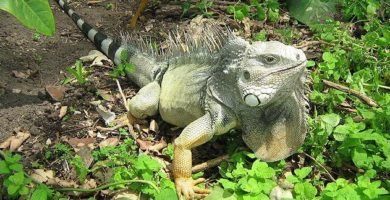
Amazon Rainforest Reptiles: snakes, lizards and turtles of the region
October 5, 2019
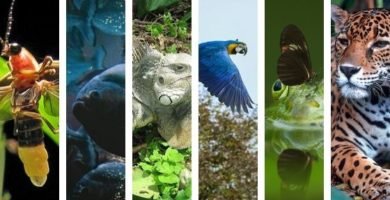
1001 Animals in the Amazon Rainforest
July 7, 2020
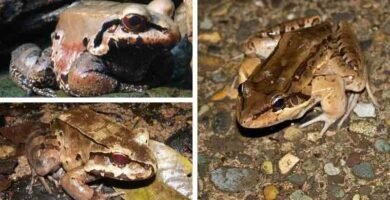
Smoky jungle frog
April 26, 2020

Yacaré Caiman – Another Amazonian crocodile
April 24, 2020
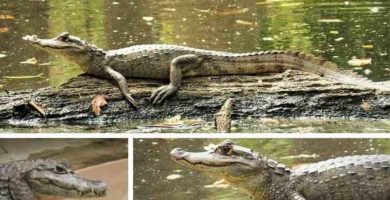
Crocodile or White Caiman
April 22, 2020
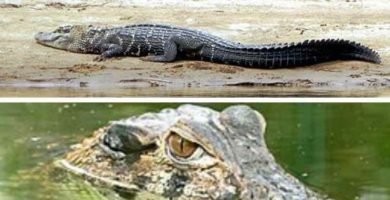
Black Caiman – A rare crocodile species
April 20, 2020
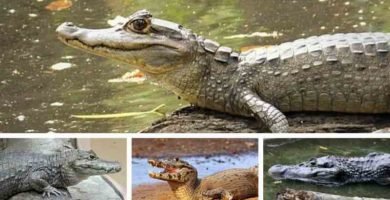
Caimans – Top Three Amazon Rainforest Crocodiles
April 10, 2020
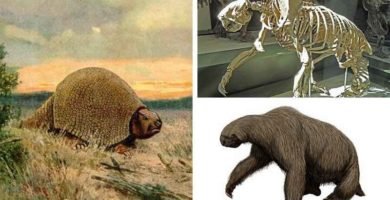
Giant animals of the Cenozoic Era in the Amazon Rainforest
This post is also available in:
![]() Español (Spanish)
Español (Spanish)
